“Use grandma’s china.” That homey-sounding advice comes from a leading nutrition expert for everyone struggling to adhere to the diet on their New Year’s resolutions list.
Joan Salge Blake, a Sargent College clinical associate professor of nutrition and health sciences, says dinner plates, like our waistlines, have ballooned since the 1960s—in the case of the plates, by 20 percent—as our meals have become supersized. Bigger plates equal bigger portions and that equals weight gain. “You eat with your eyes,” Salge Blake (SAR’84, SED’16) says. “If it’s a big plate, you will fill it up.”
Such practical, achievable steps are the essence of successful dieting and the philosophy behind the “weight management” link on Salge Blake’s website, where she lists 52 small steps people can take to manage their weight. The site covers diet, physical activity, and unproductive behaviors, such as eating when you’re stressed rather than when you’re hungry. “If every week you just added one of these tips, at the end of the year you’d have 52 small changes,” she says. If a step doesn’t strike your fancy, “then don’t do it. Go on to another one.”
Culture watchers say the year ahead is likely to usher in a number of eating trends, from veganism to Middle Eastern cuisine to low-alcohol beverages. Will staying au courant gastronomically help your diet? If not, what will? Bostonia spoke with Salge Blake for some sound weight-watching advice.
Bostonia: How do you stick to a New Year’s diet resolution?
Salge Blake: The problem is that people make too big a resolution—I’m going to get rid of carbs or get rid of gluten. The best resolutions are small and livable. When you do a big overhaul, you end up throwing in the towel long before you make substantial weight loss or changes in the diet. Small is the new big.
You’ve mentioned that people should eat more soup. How will that help you?
We have research suggesting that if you take a vegetable-based soup, like tomatoes or broth with a lot of vegetables, and you consume that prior to the meal, it can help you reduce calories at the meal by about 10 percent.
The soup will fill you up?
That’s right. It’s easier to add something to your diet than to take it away. I usually make a vat of soup on weekends. You can microwave a mug of it to take the edge off before dinner. Also, Americans are falling short of their daily vegetable servings. We should be having at least two and a half cups; we’re not anywhere near that, and this is a great way to sneak vegetables in the diet.
You can do the same thing with salads—preload your plate. Vegetables are full of fiber and water, so they’re going to fill you up before they fill you out. Make the majority of space on the plate, about half of it, vegetables and fruit.
Another problem with Americans’ diet is too much sugar. For dieters, what are the dangers of sugar?
About 13 percent of daily calories is coming from added sugars. We should be getting less that 10 percent; 13 percent is the equivalent of 25 teaspoons of added sugars a day. Americans are not so much eating it as they’re gulping it—sweetened beverages. The top sources are soft drinks, fruit drinks, and—are you ready?—coffee and tea that’s been sweetened.
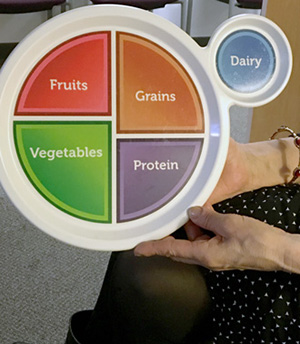
Dinner plates today are 20 percent larger than in the 1960s, says Salge Blake, displaying a plate with appropriate serving sizes marked on it. Photo by Rich Barlow
Do people put too much sugar in, or are we getting double lattes at Starbucks?
It’s a combination. The coffee is bigger, so you’re going to add more sugar. But more important, the big ticket items—I call them mocha-mocha-looka-lattes—are these designer coffees, where they’re very heavily sweetened and may even come with whipped cream. Some of these can have as many calories as a dessert, if not more.
A better approach is to wean yourself from them. If you get the 20-ounce coffee, then get the 10-ounce. Then when you get used to that, if you like the sweetness, try cappuccino. Cappuccino is just espresso with foamed milk, which tastes rich; add a little cocoa powder on top for sweetness.
Or if you go from the 20- to the 10-ounce, instead of having it five times a week, have it four times a week, and then three times a week, and have a cappuccino the other days. Wean yourself off it, rather than saying, I’m going cold turkey, because with cold turkey, you’re more likely to say, I can’t do this.
From a dieter’s perspective, are international cuisines good?
Not necessarily. You can have a lovely Middle Eastern cuisine, but if the portions are huge and the calories high, you may not have weight loss. With that said, many of the bases of Mediterranean and Middle Eastern are healthy: a lot of beans, vegetables.
What is going to be huge is legumes. They’re called pulses—chickpeas and black beans and kidney beans—and these are a big trend. They’re now making chickpea pasta, chickpea flours. It is becoming huge. The World Health Organization named this the International Year of Pulses. They’re very inexpensive, low in saturated fat, high in fiber—which can help lower blood cholesterol and make you feel more full for less—and can be put on salads or casseroles or chili or snacks.
Another trend for 2017 is veganism. Can that help you lose or maintain weight?
It possibly can, but it depends on what your diet looks like. I would highly recommend you sit down with a registered dietitian to make sure that your diet is well-balanced. There are certain nutrients that are more challenging to get in a vegan diet. Vitamin B12 only comes from animal products, whether that be milk or chicken or beef. You have to get it from another source. That could be fortified soy milk or a supplement. The other one is calcium; that would be a little challenging.
What you may want to do—back to small steps—is one day a week, you go meatless.
What about mocktails or low-alcohol drinks? Alcohol has a lot of calories.
That seems to be a trend. Mocktails would allow people to have that feeling of socialization, potentially without as many calories. But remember, you can make a mocktail that has a lot of sugar; it can be still a lot of calories.
Most research shows that while exercise has some effect on weight control, the master switch is diet, true?
That is correct. Research suggests that to lose weight, diet is key. But to maintain the weight loss, exercise becomes more important. You should be looking at your diet, moving, and watching behaviors. I often say that if people ate only when they’re hungry, I’d be out of business.









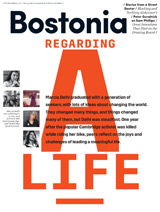










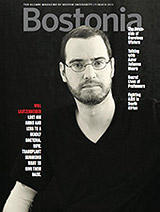











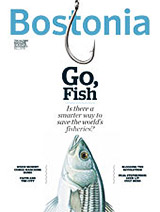












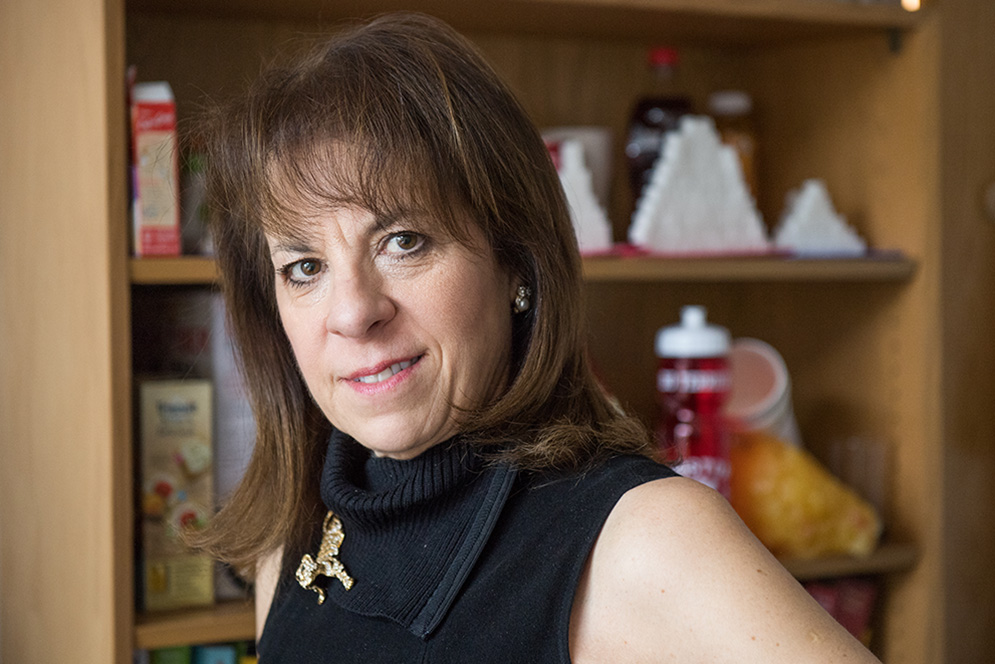

Related Stories
About Those New Year’s Resolutions
How to not quit when everyone else does
Making Sense of Latest US Dietary Guidelines
Healthy eating pattern is key to good health
When Did Tom Brady, Gwyneth Paltrow, and Kylie Jenner Become Our Doctors?
BU’s Joan Salge Blake’s new podcast Spot On! helps debunk bad advice
Post Your Comment